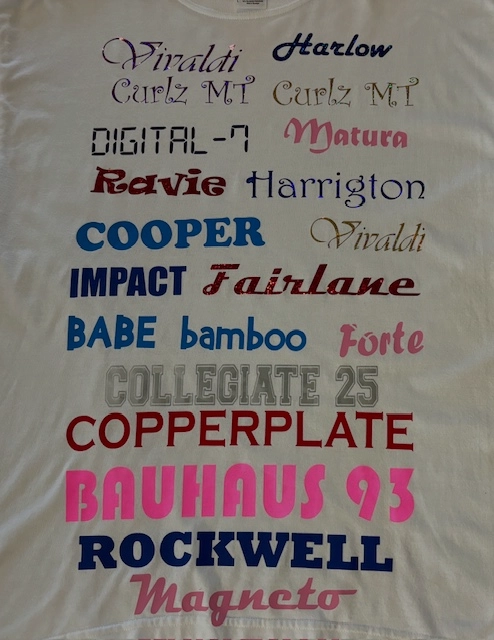Individualized Lab Coats with Embroidery for Medical Professionals
Individualized Lab Coats with Embroidery for Medical Professionals
Blog Article
The Art of Custom-made Embroidery: Opening the Secrets to Creating Distinct and Memorable Layouts
The tricks to creating custom-made embroidery layouts that captivate the eye and leave an enduring impression lie in a fragile balance of strategy, imagination, and focus to detail. As we delve right into the globe of customized embroidery, we uncover the nuanced interplay between thread choice, sew complexity, and style customization that elevates a simple garment to a work of art.
Choosing the Right Embroidery Threads
When picking embroidery strings, what crucial variables should you think about to ensure the best outcomes for your custom-made designs? The option of needlework thread is critical in identifying the last result of your embroidered style. Among the key factors to consider is the material of the thread. Various products such as cotton, polyester, rayon, and silk supply differing levels of shine, resilience, and texture. It is important to pick a string product that complements the textile you are stitching on and straightens with the desired appearance of the design.
Thicker strings can include measurement and texture to your layout, while finer threads are perfect for elaborate information and tiny text. Additionally, thinking about the shade fastness and washability of the thread is vital to make sure that your personalized styles keep their top quality and vibrancy over time.
Exploring Different Stitch Techniques
To look into the realm of 'Exploring Various Stitch Strategies', one have to comprehend the ins and outs and subtleties that each sewing approach gives the art of needlework. Various stitch methods not only include visual interest yet likewise add to the general appearance and measurement of the design. One popular stitch technique is the satin stitch, which entails carefully stuffed parallel stitches to develop a smooth and shiny surface, ideal for filling out forms and producing bold outlines.
On the other hand, the backstitch is a functional strategy often made use of for laying out and adding fine information. It entails stitching backward to create a solid line of needlework. Additionally, the French knot stitch includes a tactile component to designs, ideal for creating textured accents like flower facilities or decorative touches.
Checking out different stitch techniques permits embroiderers to play with light, darkness, and depth within their styles, elevating the aesthetic charm and imaginative quality of their embroidery tasks. By understanding numerous sewing approaches, one can open countless possibilities for producing special and remarkable custom-made embroidery pieces.
Incorporating Personalized Style Components
Having actually discovered the intricacies of different stitch strategies such as the satin stitch, backstitch, and French knot, the emphasis now moves towards integrating individualized style elements in custom-made embroidery tasks. Personalized layout components play an essential function in making embroidery jobs really special and unforgettable. One method to include personalization is by including initials, names, or considerable days to the design. This not only adds a personalized touch but likewise enhances the sentimental value of the embroidery piece.
An additional means to integrate individualized style elements is by including signs or concepts that hold special meaning to the recipient or mirror their passions and individuality. For instance, incorporating a favored blossom, pet, or hobby-related icon can make the embroidery design extra meaningful and personalized. Furthermore, selecting colors that resonate with the recipient or straighten with the intended theme can even more boost the personalization of the embroidery job.
Mastering the Art of Shade Coordination
One key facet of color control dig this is comprehending color theory. This includes understanding how different shades interact with each various other, the emotions they communicate, and how they can be integrated to develop aesthetically appealing layouts. By applying color concept principles, embroiderers can produce harmonious color palettes that boost the overall look of the design.
Additionally, paying interest to comparison is critical in shade control. Utilizing contrasting colors can aid specific aspects of the style pop, enhance readability, and create an aesthetically dynamic embroidery item. By understanding the art of shade control, embroiderers can elevate their styles and create remarkable items that reverberate useful content with customers and viewers alike.
Enhancing Texture With Advanced Needlework Stitches

French knots, as an example, are excellent for including small, raised dots to your layout, simulating the look of grains or creating a textured surface. Bullion knots, on the other hand, can be made use of to create twisted, ropelike elements that add a luxurious feel to the embroidery. Seed stitching includes small, scattered stitches that can fill out areas with a polychromatic structure, while check over here turkey job develops fluffy, dimensional accents evocative pet fur or foliage. Trying out these advanced needlework stitches allows you to press the borders of standard needlework and develop absolutely distinct and aesthetically attractive structures in your layouts.
Final Thought
In final thought, the art of custom needlework entails a combination of selecting the right threads, discovering different stitch techniques, including personalized layout aspects, mastering shade control, and boosting structure with innovative stitches. By understanding and carrying out these crucial elements, embroiderers can create one-of-a-kind and remarkable styles that display their creativity and ability. Embroidery lovers can open the keys to creating lovely and custom items that attract attention and leave a lasting perception.
Report this page